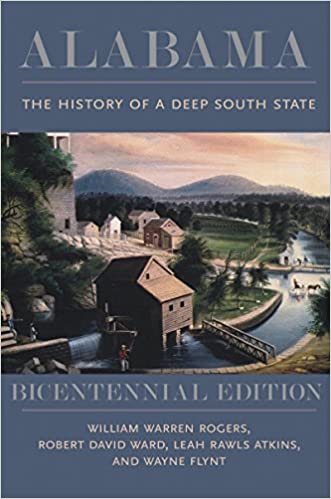Rogers, WIlliam Warrens, Robert David Ward, Leah Rawles Atkins, & Wayne Flynt. Alabama: The History of a Deep South State, Bicentennial Edition. Tuscaloosa, AL: University of Alabama Press, 2018.
This is Heather and my first new year spent in our new home of Birmingham, Alabama, and as such I can think of no better way to ring in 2022 than to review one of the first books I read upon our move: a massive history of Alabama itself, gifted to me by my former colleagues in the Bay Area. I’d never read a work of history focused on a single state of the Union before; I wasn’t sure if I would find an enlightening portrait of my unfamiliar environs, or an insular, navel-gazing account more fit for the stuffy, traditional halls of local historical societies. The answer, as it so often is, was a bit of both, but with far more pleasant surprises than I expected going in.
As any good local history must, Alabama primarily concerns itself with the themes and cycles of local Alabamian history. Narrative threads like the regional antagonism between the northern, central, and southern regions of the state; the importance and evolution of industry, class, and education; the evolution of slavery and race relations; even the value placed on sports and the arts all govern the text throughout multiple eras.
As intriguing as these are in their own right, however, even more exciting for me as an historian was how these specific Alabamian themes interacted with and complicated other, more national, historical trends with which I was more familiar. Take Reconstruction and race relations, probably the biggest historical topic I knew of concerning Alabamian history. I knew that, of course, the end of Reconstruction would lead to the nadir of race relations in the United States. While true, in Alabama’s case racist Northern Alabama Unionist whites had as much to do with ending multi-racial society as former Confederates, while Democrats would have actually preferred former slaves to vote for their candidates than not vote at all (and had no problems disenfranchising poor whites as well as blacks when it came down to it). Similarly, the legacy of elite Southern culture and racial oppression via Alabama’s convict leasing system led to a state that was uniquely hostile to labor organization and welcoming to the industry of the Gilded Age. Perhaps most surprisingly, Alabama was in fact fairly liberal through the 1930s, 40s, and early 50s; the state’s population benefited greatly from FDR’s New Deal, especially the Tennessee Valley Authority, and had begun to dismantle some segregationist policies on its own. It was only the vitriolic backlash to the 1954 Brown v. Board Supreme Court decision that turned Alabama into one of the most regressive states in the Civil Rights struggle, led by the infamous Lew Wallace (who as a younger man had been admirably egalitarian as a state justice).
One of Alabama’s flaws, however, is its elision of many of these same larger national trends. It leaves no stone of state history unturned; indeed, you might call it slightly too detailed at points, like its insistence on covering every single gubernatorial election in detail. Yet some of the major relevant points of United States history, such as the Election of 1876 which ended Reconstruction or the actual course of the Great Depression, are either only mentioned in passing or wholly absent. A learned historian, therefor, can delight in Alabama’s many connections and complications, but someone who is not familiar with larger American history will be lost, or at least miss much of the more important implications of what they’re reading.
As one of those more informed readers, however, I enjoyed Alabama much more than I would have predicted, especially given its length (over 650 pages). It feels wrong to call the history of an entire state a micro-history, but in many ways my experiences reading Alabama mirror many of the joys of reading a great case study. In this case, not only do you gain a more nuanced understanding of both micro and macro history, but you come away with all sorts of interesting local trivia (like the fact that Montgomery is actually Alabama’s third capital and that its first, Cahaba, is completely abandoned and now the site of an archaeological dig). While I’m certainly not going to make it a regular habit, I’m now considering looking into more state histories in the future, and, whether Alabama or another, I recommend others do as well.
